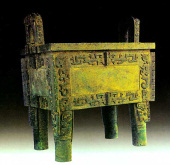Dings were used in Chinese Primitive Society as cooking utensils. At first they were made of pottery clay. Then, as they discovered and learnt more, the material was changed to bronze at the end of the Shang Dynasty about 3,000 years ago. By that time, dings had changed function to become sacrificial vessels and the symbol of their owners’ power and wealth. It is said that the King of the Shang Dynasty had the Simuwu Rectangle Ding made to commemorate his mother. The opening at the top of the Simuwu Rectangle Ding is 110 cm long and | 
|
78cm wide, its sides are 6cm thick and the loop handles are 133cm high. The whole ding weighs 75 kilograms and is the heaviest and biggest bronze item in the world. It truly is a treasure in the world’s bronze ware collection. The casting of this huge bronze vessel used over 1,000 kilograms of metal and needed 70 to 80 craftsmen to work on it.
Though the ding is big and heavy, its workmanship is exquisite. Relief of Kui, a one-legged mythical animal was carved on the four sides of the body of the ding. The animal figures are portrayed with artistic exaggeration and create a ferocious, mysterious and dignified image.
The Simuwu Rectangle Ding was so big and heavy that it could not be moved after it was unearthed, although the Japanese invaders tried several times to plunder it. To protect this rare cultural relic, the local people reburied it and then unearthed it again after China won the Anti-Japanese War in 1945. The Simuwu Rectangle Ding is now in the National Museum of Chinese History, and is a must see for anyone who has the opportunity.
|